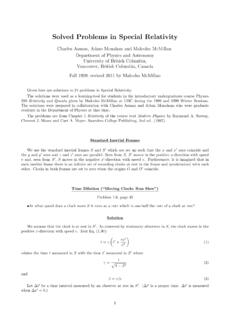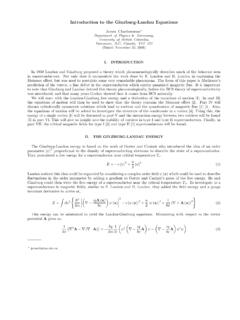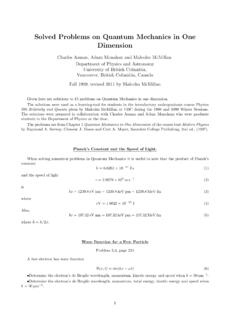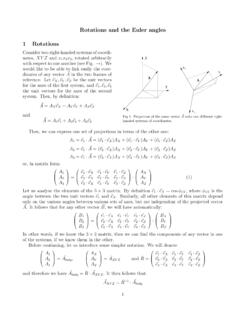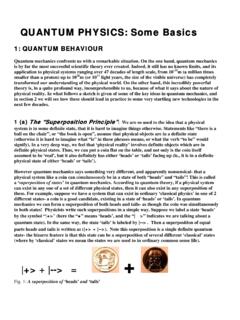Transcription of Solved Problems in the Quantum Theory of Light
1 Solved Problems in the Quantum Theory of LightCharles Asman, Adam Monahan and Malcolm McMillanDepartment of Physics and AstronomyUniversity of British Columbia,Vancouver, British Columbia, CanadaFall 1999; revised 2011 by Malcolm McMillanGiven here are solutions to 7 Problems in the Quantum Theory of solutions were used as a learning-tool for students in the introductory undergraduate course Physics200 Relativity and Quantagiven by Malcolm McMillan at UBC during the 1998 and 1999 Winter solutions were prepared in collaboration with Charles Asman and Adam Monaham who were graduatestudents in the Department of Physics at the Problems are from Chapter 2 The Quantum Theory of Lightof the course textModern PhysicsbyRaymond A.
2 Serway, clement J. Moses and Curt A. Moyer, Saunders College Publishing, 2nd ed., (1997).Planck s Constant and the Speed of solving numerical Problems in the Quantum Theory of Light it is useful to note that the product ofPlanck s constanth= 10 34J s(1)and the speed of lightc= 108m s 1(2)ishc= eV nm = keV pm = MeV fm(3)whereeV = 10 19J(4)Wien s Displacement LawProblem , page 92 The temperature of your skin is approximately 35oC. What is the wavelength at which the peak occurs in the radiation emitted from your skin?SolutionWien s displacement law, given by text Eq. ( ): maxT= 2898 m K(5)gives the wavelength maxof maximum power emission of a black body at temperatureT.
3 Thus, max= m whenT= from a Radio TransmitterProblem , page 93An FM radio transmitter has a power output of 100 kW and operates at a frequency of 94 MHz. How many photons per second does the transmitter emit?SolutionA photon of frequency 94 MHz has energyE=hf= 10 26J(6)The radio transmitter emits energy at a rate of 100 kJ/s so# photonsunit time=energy/unit timeenergy/photon= 1030s 1.(7)Photoelectric EffectProblem , page 93A Light source of wavelength illuminates a metal and ejects photoelectrons with a maximum kinetic energyof eV. A second Light source with half the wavelength of the first ejects photoelectrons with a maximumkinetic energy of eV. Determine the work function of the Eq.
4 ( ):Kmax=hc (8)relates the maximum kinetic energyKmaxof a photoelectron with the wavelength of the Light producing thephotoelectron and the work function of the was with this equation that Einstein introduced the notion of Light quanta in 1905 and for which hereceived the Nobel Prize for Physics in 1and 2be the wavelengths of the Light emitted by the first and second sources, respectively, and letK1andK2be the maximum kinetic energies of the corresponding follows from Eq. (8) thatK1=hc 1 (9)K2=hc 2 (10)where 2= 1, soK2 2K1= (11)and therefore = 2 eV whenK1= 1 eV andK2= 4 EffectProblem , page 942X-rays with an energy of 300 keV undergo Compton scattering with a target.
5 If the scattered X-rays are detected at 30 relative to the incident X-rays, determine the Compton shiftat this angle, the energy of the scattered X-ray, and the energy of the recoiling Eq. ( ) gives the increase in a photon s wavelength (the Compton shift) when it is scattered throughan angle by an electron: = e(1 cos )(12)where e=hmec= pm(13)is the Compton wavelength of the electron andme= 511 keV/c2is the mass of the electron. It follows thatthe Compton shift is pm when = 30 .The energyE of the scattered photon isE =hc (14)and =hcE(15)withE=300 keV is the wavelength of the incoming photon. It follows thatE = 278 keV. By conservation ofenergy, the energy lost by the photon in the collision is converted into kinetic energyKof the recoiling electronsoK= 22 of the Compton FormulaProblem , page 95 Derive the Compton formula Eq.
6 (12).SolutionA photon with momentump=h/ collides with a stationary electron. The photon scatters at an angle from the incident direction of the photon with momentump =hc/ . The electron scatters at an angle from the incident direction of the photon with momentumpeand energyEe= p2ec2+ the collision, energy is conserved:pc+mec2=p c+Ee(16)and so is momentum in the direction of the incident photon:p=p cos +pecos (17)and perpendicular to the direction of the incident photon:p sin =pesin (18)The above equations may be simplified to1 +1 c=1 + 1 e2+1 2c(19)1 =cos +cos e(20)3sin =sin e(21)where we have writtenpe=h/ eliminate and efrom these equations. Eliminating from last two equations yields1 2e=1 2+1 2 2 cos (22)which, with Eq.
7 (19), yields Eq. (12).Comments on the Compton derivation of the Compton formula in 1922 was the first application of the idea that the momentumpof a photon is related to its wavelength byp=h/ .The reconciliation of this wave-particle duality was resolved with the subsequent invention of QuantumMechanics and the development Quantum Electrodynamics (QED) is the relativistic Quantum Theory of Maxwell s Equations of Electro-dynamics and systems of electrons, positrons and photons. QED is the most successful relativistic quantumtheory ever developed. There are no known discrepancies between QED and the Compton Effect and the Photoelectric EffectProblem , page 95In a Compton collision with an electron, a photon of violet Light ( = 400 nm) is backward scattered throughan angle 180.
8 How much energy is transferred to the electron in this collision? Compare the result with the energy the electron would acquire in a photoelectric process with the samephoton. Could violet Light eject electrons from a metal by Compton collision? (12) with Eq. (13) gives the shift in the wavelength of a photon when it is scattered through an angle by an electron. The wavelength shift (the Compton shift) is pm when = 180 .The energy lost by the photon during the collision ishc hc =hc 'hc 2= eV.(23)By conservation of energy, this energy is converted into kinetic energyKcof the recoiling electron soKc= a photoelectric process, the entire energy of the incident photon is converted into kinetic energyKpofthe electron:Kp=hc = eV.
9 (24)The work function for a metal is typically on the order of a few eV. A Compton collision involving violetlight could not eject an electron from a metal surface since the kinetic energyKctransferred to the electron ismuch too EquationProblem , page 954X-rays of wavelength = pm from a molybdenum target are incident on a crystal with atomic planespacingd= 400 pm. Determine the three smallest angles at which intensity maxima occur in the diffracted interference occurs as given by text Eq. ( ) (the Bragg Equation):n = 2dsin (n= 1,2,3,..)(25)wherenis the order of the intensity maximum and is the angle for an intensity maximum in the diffractedbeam as measured from the top atomic three smallest angles at which intensity maxima occur are 1= sin 1( 2d)= (26) 2= sin 1( d)= (27) 3= sin 1(3 2d)= (28)5
